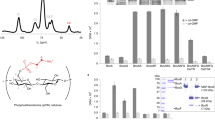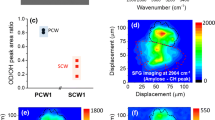Summary
Ultrastructure and assembly of cellulose terminal synthesizing complexes (terminal complexes, TCs) in the algaVaucheria hamata (Waltz) were investigated by high resolution analytical techniques for freeze-fracture replication.Vaucheria TCs consist of many diagonal rows of subunits located on the inner leaflet of the plasma membrane. Each row contains about 10–18 subunits. The subunits themselves are rectangular, approx. 7×3.5 nm, and each has a single elliptical hole which may be the site of a single glucan chain polymerization. The subunits are connected with extremely small filaments (0.3–0.5 nm). Connections are more extensive in a direction parallel to the subunit rows and less extensive perpendicular to them. Nascent TC subunits are found to be packed within globules (15–20 nm in diameter) which are larger than typical intramembranous particles (IMPS are 10–11 nm in diameter) distributed in the plasma membrane. The subunits in the globule, which may be a zymogenic precursor of the TC, are generally exhibited in the form of doublets. Approximately 6 doublets are connected to a center core with small filaments. The globules are inserted into the plasma membrane together with IMPS by the fusion of cytoplasmic (Golgi derived) vesicles. Two or three globules attach to each other, unfold, and expand to form the first subunit rows of the TC on the inner leaflet of the plasma membrane. More globules attach to the structure and unfold until the nascent TC consists of a few rows of subunits. These rows are arranged almost parallel to each other. Two formation centers of subunits appear at both ends of an elongating TC. New subunits carried by the globules are added at each of these centers to create new rows until the elongating TC structure is completed. On the basis of this study, a model of TC assembly and early initiation of microfibril formation inVaucheria is proposed.
Similar content being viewed by others
Abbreviations
- IMPS:
-
intramembranous particles
- MF:
-
microfibril
- TC:
-
terminal complex
References
Alexopoulos CJ (1962) Introductory mycology. Wiley, New York
Brown RM Jr (1985) Cellulose microfibril assembly and orientation: recent developments. J Cell Sci [Suppl] 2: 13–32
- Mizuta S (1990) High resolution replicas. US patent No. 4,967,825. Nov. 6, 1990
—, Montezinos D (1976) Cellulose microfibrils: visualization of biosynthetic and orienting complexes in association with the plasma membrane. Proc Natl Acad Sci USA 73: 143–147
—, Willison JHM, Richardson CL (1976) Cellulose biosynthesis inAcetobacter xylinum: visualization of the site of synthesis and direct measurement of the in vivo process. Proc Natl Acad Sci USA 73: 4565–4569
Bureau TE, Brown RM Jr (1987) In vitro synthesizing cellulose II from a cytoplasmic membrane fraction ofAcetobacter xylinum. Proc Natl Acad Sci USA 84: 6985–6989
Frey-Wyssling A, Mühlethaler K (1963) Die Elementarfibrillen der Cellulose. Makromol Chemie 62: 25–30
Giddings TH, Brower DL, Staehelin LA (1980) Visualization of particle complexes in the plasma membrane ofMicrasterias denticulata associated with the formation of cellulose fibrils in the primary and secondary cell walls. J Cell Biol 84: 327–339
Haigler CH, Brown RM Jr (1986) Transport of rosettes from the Golgi apparatus to the plasma membrane in isolated mesophyll cells ofZinnia elegans during differentiation to tracheary elements in suspension culture. Protoplasma 134: 111–120
Itoh T, Brown RM Jr (1984) The assembly of cellulose microfibrils inValonia macrophysa Kutz. Planta 160: 372–381
— — (1988) Development of cellulose synthesizing complexes inBoergesenia andValonia. Protoplasma 144: 160–169
—, O'Neil RM, Brown RM Jr (1984) Influence of cell wall regeneration ofBoergesenia forbesii protoplasts by Tinopal LPW, a fluorescent brightening agent. Protoplasma 123: 174–183
Kiermayer O, Sleytr UB (1979) Hexagonally ordered “rosettes” of particles in the plasma membrane ofMicrasterias denticulata Breb. and their significance for microfibril formation and orientation. Protoplasma 101: 133–138
Kuga S, Brown RM Jr (1989) Correlation between structure and the biogenic mechanisms of cellulose: new insights based on recent electron microscopic findings. In: Schuerch C (ed) Cellulose and wood-chemistry and technology. Wiley, New York, pp 677–688
Mizuta S (1985 a) Evidence for the regulation of the shift in cellulose microfibril orientation in freeze-fractured plasma membrane ofBoergesenia forbesii. Plant Cell Physiol 26: 53–62
— (1985 b) Assembly of cellulose synthesizing complexes on the plasma membrane ofBoodlea coacta. Plant Cell Physiol 26:1443–1453
—, Brown RM Jr (1989) Freeze fracture analysis of cellulose terminal synthesizing complexes inVaucheria. In: Bailey GW (eds) Proceedings 47th Annual Meeting EMSA. San Francisco Press, San Francisco, pp 772–773
— — (1992) Effects of 2,6-dichlorobenzonitrile and Tinopal LPW on the structure of the cellulose synthesizing complexes ofVaucheria hamata. Protoplasma 166: 200–207
—, Okuda K (1987) A comparative study of cellulose synthesizing complexes in certain cladophoralean and siphonocladalean algae. Bot Mar 30: 205–215
—, Roberts EM, Brown RM Jr (1989) A new cellulose synthesizing complex inVaucheria hamata and its relation to microfibril assembly. In: Schuerch C (ed) Cellulose and wood-chemistry and technology. Wiley, New York, pp 659–676
Mueller SC, Brown RM Jr (1980) Evidence for an intramembrane component associated with a cellulose microfibril-synthesizing complexes in higher plants. J Cell Biol 84: 315–326
Okuda K, Mizuta S (1987) Modification in cell shape unrelated to cellulose microfibril orientation in growing thallus cells ofChaetomorpha moniligera. Plant Cell Physiol 28: 461–473
Ott DW, Brown RM Jr (1972) Light and electron microscopical observations on mitosis inVaucheria litorea Hofman ex. C. Agardh. Br Phycol J 7: 361–374
— — (1974) Developmental cytology of the genusVaucheria I. Organization of the vegetative filament. Br Phycol J 9: 111–126
Parker CW, Preston RD, Fogg EG (1963) Studies of the structure and chemical composition of the cell walls ofVaucheria andSaprolegniaceae. Proc Roy Soc B 158: 435–445
Peng HB, Jaffe LF (1976) Cell wall formation inPelvetia embryos. A freeze-fracture study. Planta 133: 57–71
Preston RD (1974) The physical biology of plant cell walls. Chapman and Hall, London
Provasoli L, McLanghlin JJA, Droop MR (1957) The development of artificial media for marine algae. Arch Mikrobiol 25: 392–428
Reiss HD, Schnepf E, Herth W (1984) The plasma membrane of theFunaria caulonema tip cells: morphology and distribution of particle rosettes, and the kinetics of cellulose synthesis. Planta 160: 428–453
Robinson DG, Preston RD (1972) Plasmalemma structure in relation to microfibril biosynthesis inOocystis. Planta 104: 234–246
Sugiyama J, Harada H, Fujiyoshi Y, Uyeda N (1985) Lattice images from ultrathin sections of cellulose microfibrils in the cell wall ofValonia macrophysa Kutz. Planta 166: 161–168
Wada M, Staehelin LA (1981) Freeze-fracture observation on the plasma membrane, the cell wall and the cuticle of growing protonemata ofAdiantum capillus-veneris L. Planta 151: 462–468
Author information
Authors and Affiliations
Rights and permissions
About this article
Cite this article
Mizuta, S., Brown, R.M. High resolution analysis of the formation of cellulose synthesizing complexes inVaucheria hamata . Protoplasma 166, 187–199 (1992). https://doi.org/10.1007/BF01322781
Received:
Accepted:
Issue Date:
DOI: https://doi.org/10.1007/BF01322781




